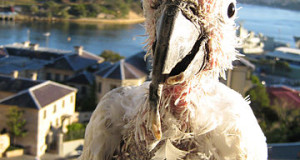Peer into a nest containing hungry Estrildid (order Estrildidae) finches and you may be surprised by the array of colors and odd tongue and mouth markings that greet you.
Mouth Adornments in Three Common Finches
Gouldian finch chicks sport bright blue and yellow nodules in their capacious gapes. Like those of related species, these reflect what little light is available in the dark nest hollow, and no doubt guide the parents during feeding.
Zebra finches take the strategy a bit further…in addition to black and yellow markings in the mouth, their tongues bear distinctive nodules that move about as the chicks beg for food.
The colorful firetail finch parent is guided to its chicks even before they open their mouths, as each bears a stark white flange of skin along the sides of the bill. Once opened, the mouths reveal a series of bright yellow and black nodules.
Deceiving Parasites?
In addition to their obvious role in garnering a meal, mouth markings may serve to deter parents from feeding the young of brood parasites – birds which lay their eggs in the nests of other species, leaving the chicks to be reared by unwitting foster parents.
Indeed, species whose chicks have distinctive mouth markings often make poor foster parents in captivity (fostering is commonly used when parents reject young, or if eggs are pulled in order to stimulate a second clutch). Zebra finches, for example, often reject the chicks of other species, and may even fail to properly feed their own albino or pale-colored offspring (such chicks often have indistinct mouth markings).
Birds have innumerable strategies to assure that their chicks reach adulthood…please pass along your own thoughts and questions.
The abstract of an article that proposes interesting theories for the development of mouth markings is posted at:
http://www.springerlink.com/content/4462l15300172428/
Image referenced from Wikipedia creative Commons: http://en.wikipedia.org/wiki/Image:IMG_2535_1000_crop.jpg
 That Bird Blog – Bird Care and History for Pet Birds
That Bird Blog – Bird Care and History for Pet Birds



